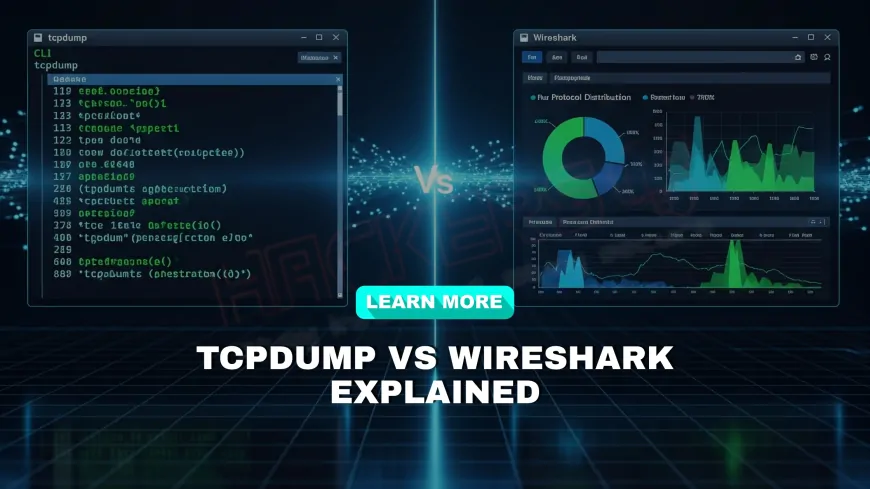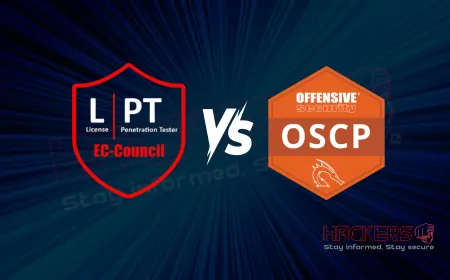What Is the Difference Between Wireshark and tcpdump for Packet Analysis?
Ever wondered what’s happening under the hood of your network? Whether you’re a cybersecurity student, an IT professional, or just curious about how data travels across the internet, packet analysis is your window into the world of network traffic. Two tools often come up in this space: Wireshark and tcpdump. Both are powerful for capturing and analyzing network packets, but they serve different purposes and cater to different users. In this 3000-word blog post, we’ll dive into the differences between Wireshark and tcpdump, explaining their features, strengths, and use cases in a way that’s easy to understand, even for beginners. Packet analysis involves capturing and inspecting data packets to troubleshoot network issues, detect intrusions, or learn how networks operate. Wireshark and tcpdump are go-to tools for this, but their approaches differ significantly. Let’s explore what sets them apart and how they can help you master network analysis.

Table of Contents
- What Is Packet Analysis?
- Overview of Wireshark
- Overview of tcpdump
- Wireshark vs. tcpdump: Key Differences
- Use Cases for Wireshark and tcpdump
- How to Get Started with Wireshark and tcpdump
- Conclusion
- Frequently Asked Questions (FAQs)
What Is Packet Analysis?
Packet analysis is the process of capturing and examining data packets as they travel across a network. Packets are small chunks of data that devices send and receive, containing information like source and destination addresses, protocols, and payloads. By analyzing packets, you can troubleshoot network performance, identify security threats, or debug applications. Tools like Wireshark and tcpdump capture these packets, allowing you to inspect their contents and understand network behavior.
For beginners, think of packet analysis as eavesdropping on a conversation between devices. Wireshark and tcpdump are like different types of listening devices—one with a user-friendly display and another that’s lightweight and command-line-based. Let’s break down each tool.
Overview of Wireshark
Wireshark is a free, open-source packet analyzer known for its graphical user interface (GUI). It’s widely used by cybersecurity professionals, network administrators, and students because it makes packet analysis accessible and visual. Wireshark captures packets in real-time or from saved files and displays them in a detailed, easy-to-read format, showing protocols, packet contents, and more.
- Graphical Interface: Wireshark’s GUI shows packets in a table with columns for time, source, destination, protocol, and details, making it easy to navigate.
- Powerful Filters: It offers display filters (e.g.,
ip.addr == 192.168.1.1) to focus on specific traffic, like HTTP or DNS. - Cross-Platform: Available on Windows, macOS, and Linux, Wireshark is versatile for any user.
- Deep Packet Inspection: Wireshark decodes packet contents, showing data like HTTP requests or email headers.
Wireshark is ideal for those who prefer a visual approach and need detailed analysis without diving into command-line complexity.
Overview of tcpdump
tcpdump is a command-line packet analyzer that’s lightweight, powerful, and pre-installed on many Linux and Unix systems. It’s a favorite among advanced users who need a quick, efficient tool for capturing and analyzing packets. Unlike Wireshark, tcpdump doesn’t have a GUI, relying instead on terminal commands to capture and display packet data.
- Command-Line Interface: tcpdump operates via terminal commands, offering flexibility for scripting and automation.
- Lightweight: It uses minimal system resources, making it ideal for servers or low-power devices like Raspberry Pi.
- Packet Capture Focus: tcpdump excels at capturing packets to a file (e.g., .pcap) for later analysis, often with other tools like Wireshark.
- Filter Syntax: It uses Berkeley Packet Filter (BPF) syntax (e.g.,
host 192.168.1.1) to capture specific traffic.
tcpdump is perfect for users comfortable with the command line or those working in environments where a GUI isn’t practical.
Wireshark vs. tcpdump: Key Differences
To understand which tool suits your needs, let’s compare Wireshark and tcpdump across key features:
| Feature | Wireshark | tcpdump |
|---|---|---|
| Interface | Graphical (GUI) | Command-line |
| Ease of Use | Beginner-friendly | Requires command-line knowledge |
| Resource Usage | Higher (GUI-based) | Low (lightweight) |
| Filtering | Display and capture filters | Capture filters (BPF) |
| Analysis Depth | Detailed (deep packet inspection) | Basic (capture-focused) |
| Platform | Windows, macOS, Linux | Linux, Unix, macOS |
| File Output | .pcap, .pcapng | .pcap |
This comparison shows Wireshark’s strength in visual analysis and tcpdump’s efficiency for quick captures and automation.
Use Cases for Wireshark and tcpdump
Both tools shine in different scenarios. Here’s how cybersecurity professionals and students use them:
- Wireshark Use Cases:
- Troubleshooting Network Issues: Analyze slow network performance by examining packet loss or latency in the GUI.
- Security Analysis: Detect suspicious traffic, like malware communication, by inspecting packet contents.
- Learning Protocols: Study HTTP, DNS, or TCP headers in detail to understand how protocols work.
- Forensic Investigations: Analyze saved .pcap files to reconstruct network activity after an incident.
- tcpdump Use Cases:
- Server Monitoring: Capture packets on a headless server where a GUI isn’t available.
- Automation: Use tcpdump in scripts to monitor traffic or detect anomalies in real-time.
- Resource-Constrained Devices: Run captures on devices like Raspberry Pi with minimal resource usage.
- Quick Captures: Save traffic to a .pcap file for later analysis in Wireshark or other tools.
Both tools can complement each other—use tcpdump to capture packets efficiently and Wireshark to analyze them in depth.
How to Get Started with Wireshark and tcpdump
Ready to try these tools? Here’s a beginner-friendly guide to get started:
- Wireshark:
- Install: Download Wireshark from www.wireshark.org for Windows, macOS, or Linux. It’s pre-installed on Kali Linux.
- Capture Packets: Open Wireshark, select a network interface (e.g., Wi-Fi or Ethernet), and start capturing.
- Apply Filters: Use filters like
httpto view only HTTP traffic orip.addr == 192.168.1.1for specific IP addresses. - Analyze: Click on packets to view details, such as protocol headers or data payloads.
- Example: To capture HTTP traffic:
1. Start Wireshark. 2. Select your network interface. 3. Enter filter: http 4. Click "Start" to capture.
- tcpdump:
- Install: tcpdump is pre-installed on most Linux/Unix systems. For Windows, use WinDump or install via WSL.
- Capture Packets: Run a command like
sudo tcpdump -i eth0to capture packets on the eth0 interface. - Apply Filters: Use BPF filters, e.g.,
tcpdump host 192.168.1.1to capture traffic for a specific IP. - Save to File: Use
tcpdump -i eth0 -w capture.pcapto save packets for later analysis. - Example: To capture HTTP traffic on port 80:
sudo tcpdump -i eth0 port 80 -w http_capture.pcap
Practice in a lab environment (e.g., a virtual network with VirtualBox) to avoid capturing sensitive data.
Conclusion
Wireshark and tcpdump are essential tools for packet analysis, each catering to different needs in the cybersecurity world. Wireshark’s graphical interface and deep inspection capabilities make it ideal for beginners and detailed analysis, while tcpdump’s lightweight, command-line approach suits advanced users and resource-constrained environments. By understanding their differences and use cases, you can choose the right tool for troubleshooting, security analysis, or learning network protocols. Whether you’re visualizing traffic with Wireshark or scripting captures with tcpdump, both tools empower you to master packet analysis. Start experimenting in a safe lab today and unlock the secrets of your network!
Frequently Asked Questions (FAQs)
What is packet analysis?
Packet analysis involves capturing and examining network packets to troubleshoot issues, detect threats, or study protocols.
What is Wireshark used for?
Wireshark is used to capture and analyze network packets with a graphical interface, ideal for troubleshooting and security analysis.
What is tcpdump used for?
tcpdump captures network packets via the command line, great for quick captures, automation, and low-resource environments.
Is Wireshark free?
Yes, Wireshark is free and open-source, available for Windows, macOS, and Linux.
Is tcpdump free?
Yes, tcpdump is free and pre-installed on most Linux and Unix systems.
Can beginners use Wireshark?
Yes, Wireshark’s graphical interface is beginner-friendly, making packet analysis accessible.
Is tcpdump beginner-friendly?
tcpdump requires command-line knowledge, so it’s better suited for users with some technical experience.
Can Wireshark and tcpdump work together?
Yes, tcpdump can capture packets to a .pcap file, which Wireshark can then analyze in detail.
What is a .pcap file?
A .pcap file is a standard format for storing captured network packets, used by both Wireshark and tcpdump.
Can Wireshark run on Linux?
Yes, Wireshark runs on Linux, Windows, and macOS, and is pre-installed on Kali Linux.
Can tcpdump run on Windows?
tcpdump is primarily for Linux/Unix, but WinDump provides similar functionality on Windows.
What are Wireshark filters?
Wireshark filters (e.g., http or ip.addr == 192.168.1.1) let you focus on specific network traffic.
What are tcpdump filters?
tcpdump uses Berkeley Packet Filter (BPF) syntax, like host 192.168.1.1, to capture specific traffic.
Is Wireshark resource-intensive?
Wireshark uses more resources due to its GUI, especially for large captures, compared to tcpdump.
Can tcpdump analyze packet contents?
tcpdump focuses on capturing packets; detailed analysis is better suited for tools like Wireshark.
Is it legal to use Wireshark or tcpdump?
Both are legal for analyzing networks you own or have permission to monitor; unauthorized use may be illegal.
Can Wireshark detect malware?
Yes, Wireshark can detect suspicious traffic patterns, like malware communication, by analyzing packet contents.
Can tcpdump be automated?
Yes, tcpdump’s command-line nature makes it ideal for scripting and automation in network monitoring.
Where can I learn Wireshark?
Visit www.wireshark.org for tutorials or use platforms like TryHackMe for hands-on practice.
Where can I learn tcpdump?
Check tcpdump’s man page (man tcpdump) or online resources like Linux tutorials for guidance.
What's Your Reaction?










































































